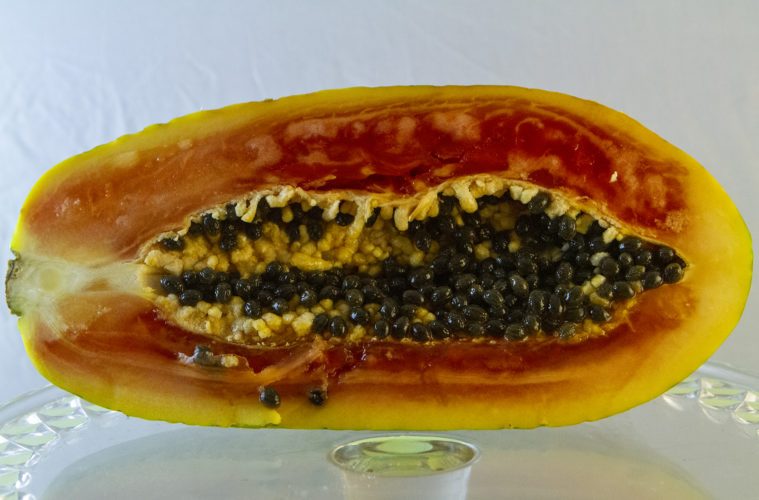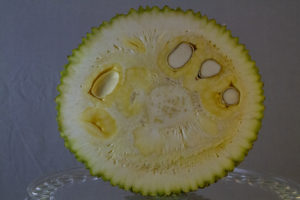
Jackfruit
As a food, wine, and travel writer it should come as no surprise that I love watching travel shows. I used to marvel at the places Anthony Bourdain would visit, and how he would strive to taste everything, and I mean everything, that was offered to him. I’m a big fan of Phil Rosenthal, and I love his Somebody Feed Phil series on Netflix. While watching Phil at a street market in Brazil, tasting exotic fruit indigenous to the area, it made me wonder what they tasted and smelled like. I wanted to be there, too.
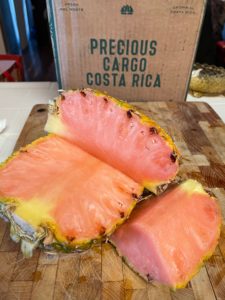
Pinkglow Pineapple
I reached out to my friends at Melissa’s Produce in L.A. and asked them if they could provide some unique, exotic fruits. They delivered and how! My first box arrived with a Pinkglow pineapple inside. That was followed by a box containing passionfruit, red papaya, cherimoya, and butterscotch pears. Finally, I received a box containing a variety of bananas; red bananas, burro bananas, baby bananas, Manzano bananas, and plantains. Did you know there are more than a thousand different varieties of bananas???
Called the Jewel Of The Jungle, at first glance the Pinkglow looked just like any other pineapple. Once you cut into it, though, all bets are off. It doesn’t just have a tinge of pink, it’s screaming pink! Grown only in Costa Rica, the Pinkglow arrives minus its crown. The crowns are cut off and replanted in a measure of sustainability. When you cut it, you get a strong pineapple smell. The pink flesh is incredible to behold. At first bite, you notice it’s less sour than a regular pineapple, and the flavor is definitely similar to pineapple, but it’s sweeter and juicier. Melissa’s offers recipes on their website.
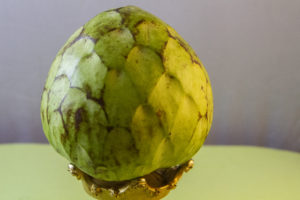
Cherimoya
The next package to arrive was bursting at the seams with an abundance of exotic treats. I decided to delve into the Cherimoya first. Cherimoya is believed to have originated in Central America. Today it grows in tropical regions in Central and South America as well as Spain and Italy. It’s also grown in Santa Barbara County. Mark Twain called it the “most delicious fruit known to man.” This fruit is soft and creamy, and is also known as the custard apple. It’s sweet and delicious with large black seeds. It’s available from Melissa’s year-round, from Chile from May to November, and from California from November to April.

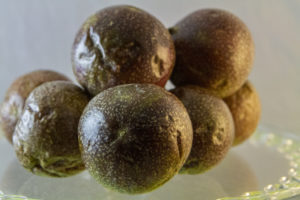
Passion Fruit
I love passion fruit and I’m very familiar with it. I’ve even had them growing in my back yard. The fruit you see pictured here is not completely ripe. When the skin is fully wrinkled is when you want to eat it. Passion fruit begins as a stunningly beautiful flower and technically is a berry. The inside is jelly-like with edible seeds. It starts out quite tart and becomes very sweet. Simple to eat, you just cut it and scoop out the flesh. Melissa’s gets theirs from New Zealand and the US and they’re available February – June, and August – November. 
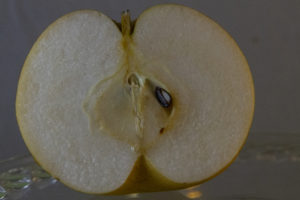
Butterscotch Pear
Melissa’s gets their Butterscotch Pears from South Korea, and they’re a real treat. The easiest way to describe them is a cross between an apple and a pear. The skin is quite thin, and they have the crispy crunch of a firm apple and the taste of a pear. As with everything from Melissa’s Produce, look for recipes on their website. How about Butterscotch Pear coconut macaroons, or bacon griddle cakes?

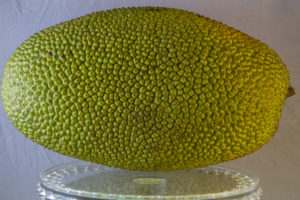
Jackfruit
Have you ever seen a Jackfruit? For starters, they’re massive, averaging 14 – 25 pounds. Jackfruit have been known to grow as large as 120 pounds. Melissa’s supplies instructions on how to cut them for a very good reason. They suggest you wear rubber gloves and line your cutting board with plastic wrap. When you cut a jackfruit, you discover they are one of the stickiest substances known to man. Preparing a jackfruit for eating requires some work and patience. You’ll need a very sharp knife. I suggest you use a serrated blade. They are tough to cut through. Once you’ve cut across the entire fruit into two-inch slices, you then cut those slices in half, break out the pods, and remove the white fibers, and the seeds. It’s quite labor-intensive, but the payoff is big.

The pods have a distinctly tropical flavor, with hints of banana and mango. They’re also quite fragrant. There’s a slight crunch to it. They are a good source of vitamin C and potassium, and the seeds can be boiled and eaten. Melissa’s offers tasty recipes, including jackfruit sliders and sundaes.
 I ended my exotic journey with five different types of bananas. You may think a banana is a banana, but you’d be mistaken. These bananas ripen at wildly different rates. You’re likely familiar with the Cavendish banana. That’s the one you commonly see in the produce section. It’s not uncommon to see plantains, and I have spotted baby (or finger) bananas from time to time, but that’s about it. As I mentioned earlier, there are more than a thousand different varieties of bananas. I got to try five.
I ended my exotic journey with five different types of bananas. You may think a banana is a banana, but you’d be mistaken. These bananas ripen at wildly different rates. You’re likely familiar with the Cavendish banana. That’s the one you commonly see in the produce section. It’s not uncommon to see plantains, and I have spotted baby (or finger) bananas from time to time, but that’s about it. As I mentioned earlier, there are more than a thousand different varieties of bananas. I got to try five.
We’ll begin with what got ripe first. It’s important to understand these aren’t the garden variety of bananas you’re used to. A few turned yellow and looked ripe, but they weren’t. Patience is truly a virtue here. Most of these were just hitting their stride when they started developing brown spots. The red banana and plantain were totally dark, but not overripe. The little ones ripened first, baby bananas and the Mannzanos. Again, wait until they get a few brown spots, especially the Manzano. The babies are sweet with a hint of cinnamon. Manzano has a slight strawberry flavor.
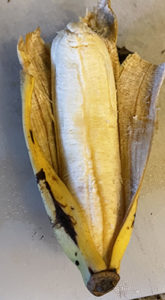
Ripe Burro Banana
Next to ripen was the red banana. Its skin was totally brown, but it was perfectly ripe and delicious. It took about a week to 10 days from when I received them until they ripened. This may have been my favorite of the bananas. It’s nice and sweet and has a slight raspberry flavor.
The burro banana fooled me at first. It appeared perfectly ripe and was slightly soft to the touch, however, when I peeled it, it was firm and not very sweet. A week later, after developing a few brown spots, it was perfect. Like all the others it tasted like a banana. The color was almost yellow when cutting it, and it had a creamy texture.
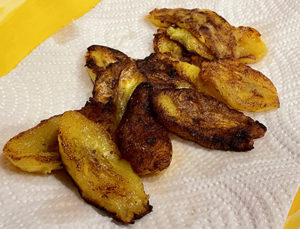
Fried Plantain
Finally, I got to the plantain. The largest of the lot, plantains need to be cooked. I went the simple route, slicing it diagonally and frying it in a bit of vegetable oil until golden brown on both sides. I sprinkled a bit of salt on it and it was divine. Plantains are readily available and I plan on using them more often.
This was a fun and tasty expedition I took without ever leaving my home. Melissa’s Produce has a mind-blowing assortment of fruits and vegetables and a wealth of recipes. All of these can be ordered from their website. I highly recommend you try some or all of these tasty treats. I’m sure glad I did! Visit melissas.com

